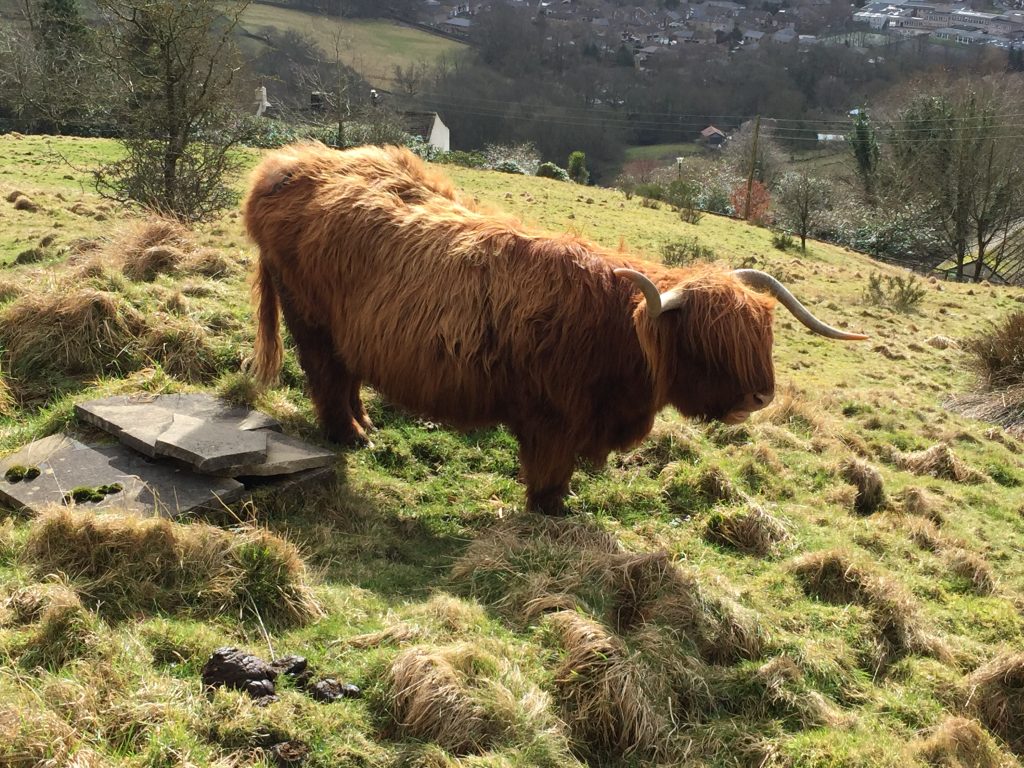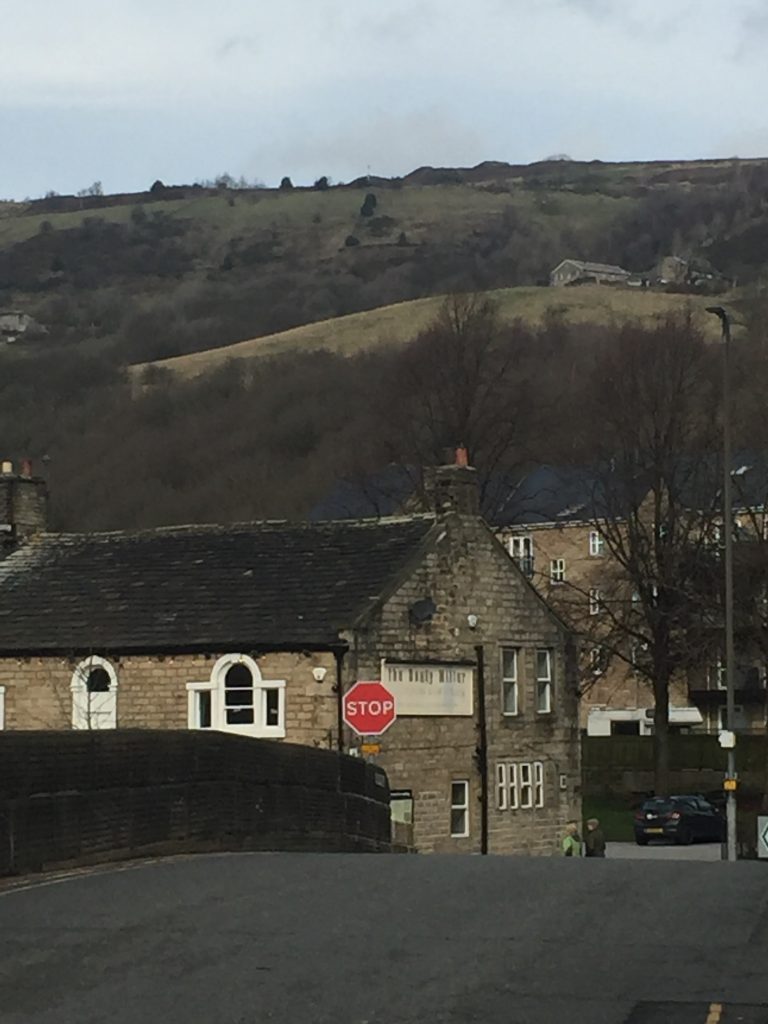2.FANNY GREENWOOD (This being chapter 2 of my ’13 Untimely Deaths’)
Willie Wrigley is James and Mally’s great grandson
It was May, 2020. The country, indeed much of the world, was in lockdown – the Coronavirus pandemic. Yet here I stood on a remote hillside with a panoramic view of the Calder Valley. Atop Erringden Moor Stoodley Pike rose like an eagle commanding a view of its territory, but it’s a black eagle, no hint of gold on its ‘phallic spike.’ 1 The bleat of new born lambs filled the still air, a joyous sound now no longer obliterated by the overhead roars of planes on their flight to distant lands. A highland cow had introduced herself to me as I strolled along Burlees Lane, high above Hebden Bridge but her eyes warned me not to enter her field despite the public footpath sign.

It had been a steep climb up Wadsworth Lane, passing the housing estate of Dodd Naze on my left while to my right was open pasture but now I had a bird’s eye view of the Calder Valley and the small town of Mytholmroyd. Even though this town with its tongue twisting name is only 2 miles East of Hebden Bridge the valley here is much wider here with more expansive flat areas with scattered buildings , quite different from the tightly packed houses on top of each other, accessible by steep stone staircases.

I was in search of Hill House, birthplace of one of my ancestors, Charlotte Greenwood. I turned off the main road onto a small unpaved lane, Raw Lane. Ancient cottages now mostly restored and exuding affluence, their windows overlooking a dramatic landscape are dotted along its length, seemingly at random, some with their front doors opening directly onto the lane and others set back. In places Raw Lane is tree lined and at this time of year the trees heavy with leaves bowed their boughs forming an arch above me for me to walk through onto centre stage. The scent of the white hawthorn flowers was everywhere, reminding me of the hawthorn tree close to my childhood bedroom window at Affetside, and the brilliant yellow gorse flowers vied with a field of vibrant yellow buttercups for the prize of best in show. Today the verges were ablaze with colour. Foxgloves stood tall, proudly displaying their pendulous bell-like blooms and as I became aware that my jacket perfectly matched their shade of purple-pink I assured the busy bees that I was bereft of pollen.

Yet I had walked along with path in Autumn when the fog was so dense I could hardly see the roadside verges, let alone the expanse of the Calder Valley. Winters up here can be treacherous with ice and snow in abundance, and even today bins of grit lined the path reminding me of those dark days of winter when the lane lives up to its name. With map in hand I picked out Hill House to my right, perched alone on top of a smooth sided grass-green hill, devoid of trees, and justifying its name 100%.

A man was gardening at Hill House Lane Top and I chatted to him, admiring the lovely view his house had before taking the poppy lined cobbled track down towards my destination passing a beautifully landscaped garden with an ornamental pond and just as I approached the ancient stone house with its large barn across the yard a woman came into view, the current owner. I explained my quest and she was interested enough to bring out to me a framed aerial photo of the property taken about thirty years ago. It brought back memories of a similar photograph of my home at Third Bungalow, Affetside, framed and sitting in pride of place on top of my piano for many years. It had been taken from a helicopter some time in the 1970s and the pilot had landed in our field. Back at Hill House the owner pointed out a date stone above the front porch of 1678 and the initials IMG but she assured me that the building was significantly older than the stone indicated and that this was the date commemorating a rebuild.

With an invitation to return after lockdown was over I took my leave and she directed me to a path running behind the house enabling me to hike back into the valley a different way, following the outline of the hill which gives the house its name. I found myself crossing a beautiful meadow awash with wild flowers, clovers, cowslip and buttercups before reaching Red Acre Wood. Much work has been done to preserve the footpaths traversing this woodland sanctuary but the path remains steep, often with stairways and I had to keep my focus on my footsteps until I reached the valley floor from where I looked back and could see, high above, Hill House, perched atop its hill, birthplace of Charlotte Greenwood. In the Spring of 1894 Charlotte married Willie Wrigley, the great grandson of James and Mally, my 4th great grandparents who had lived at Lily Hall. Willie was an architect of some renown.

I knew that Charlotte and Willie had a turbulent life together and his desertion of his wife and children resulted in a 3 month incarceration with hard labour in Wakefield gaol in 1901. But as I chatted to the current owner of Hill House that Spring morning I wasn’t aware of a tragedy that had occurred there one hundred and sixty years ago. A search later that evening produced an account in the newspaper that chilled me to the bone.
An article in the Sheffield Daily Telegraph 4th Nov 1861 reads ‘Murder and Suicide by a Mother Mytholmroyd: On Friday last, at midday, a most awful tragedy was perpetrated at Hill House, Wadsworth, Mytholmroyd, by a married woman, named Greenwood, wife of Mr. Greenwood, farmer. It appears that during the forenoon Mr. Greenwood had gone to Mytholmroyd with a week’s butter, and while away his wife cut the throat of her little daughter, about five years old, after which she cut her own throat, and ran out bleeding profusely into the house of a neighbour, (living at Hill House Lane Top where I’d chatted to the owner) named Sutcliffe, and then ran back into her own house. She still had the razor in her hand. Sutcliffe took it from her, and the mother pointed to the child in an adjoining room, with its head almost severed from its body. It would seem she had had two razors at work; one was also lying on the table, opposite the looking glass, covered with blood, along with two empty razor cases. The house presented more the appearance of a slaughter-house than human dwelling, such was the quantity of blood on the floors. The little girl’s hands were tied with a shred of cotton lining. Mrs. Greenwood has been in a desponding state of mind for some time, but not so much so as to cause much alarm. Since the above was written, it is reported that Mrs. Greenwood is dead also.” 2

I found over sixty accounts of this tragedy in various newspapers, the story being reported as far away as Ireland, Wales and Scotland but only the Hull Advertiser suggested a reason for the tragedy. “She had been depressed in spirits for some time in consequence of her husband’s ill luck in business as a farmer, and also in consequence of the helpless and idiotic state of the child brought on by the violent fits to which it had been subject for two or three years.” 3
Three and a half years after the devastating death of both his wife and child James Greenwood remarried. I mean, it’s not surprising. He had four remaining children under eight years old and he had a farm of 28 acres to look after. Following his marriage to Elizabeth Jackson at Mytholmroyd church the couple had three more children, the youngest being ‘my’ Charlotte born in 1871. James and Elizabeth continued to live at Hill House for the rest of their lives and as I picked my way carefully along the steep path through Red Acre Wood I wondered what ghosts penetrated their lives there.

Emerging from the dark density of the woodsI found myself in the centre of a bright and sunny Mytholmroyd. This small town on the River Calder lies at the junction of Cragg Brook and the River Calder and the valley floor here is much wider than the narrow cleft in which Hebden Bridge cowers, just two miles to the East. Yet its propensity to flooding is equal to that of its neighbour and TV crews covering the floods often have a particular difficulty in pronouncing the town’s name, meaning a clearing where two streams meet. After a few minutes’ walk along the towpath towpath I crossed the canal, the road and the river and arrived at the church, in search of the resting place of Fanny. It didn’t take me long in this well kept cemetery to find her grave, in which her daughter, Grace, also rests. So too is Grace’s sister, Sarah, aged 14 and Ann, aged 25. Fanny’s husband James lived to a grand old age of 72, and his second wife rests there too.

At that moment the church bell struck the hour and as I looked up at the asymmetrical church tower the outline of Hill House perched on its hill appeared to be directly the tower. Grave That morning on my way to find Charlotte’s birthplace I’d looked down with pleasure at Hill House and its commanding position and chatted happily with the owner. I know now that the place will hold different memories for me whenever I see it perched on the hill looking out to Mytholmroyd.

1 Glyn Hughes Millstone Grit p. 60
2 https://www.britishnewspaperarchive.co.uk/viewer/BL/0000250/18611104/049/0002?browse=False
3 https://www.britishnewspaperarchive.co.uk/viewer/BL/0001280/18611109/108/0005?browse=False
Very interesting and sad account of Fanny and Grace. I can’t imagine the desperation of Fanny.
A tragic family.
I know this story because Fanny is a relation of mine.